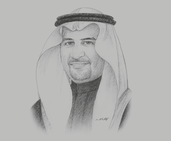What makes the Kingdom’s mining sector attractive to local and foreign investors?
AL MUDAIFER: The Kingdom of Saudi Arabia is significantly underexplored compared to other industry-leading countries, such as Australia and China. As a result, it provides huge exploration and development opportunities, which are now becoming more recognised in mining, minerals and metals industries across the world. The sector has been able to secure key upstream players, such as Mosaic in phosphate, Alcoa in aluminium and Barrick in gold. Ma’aden works in all of these commodities, with phosphate representing the biggest share of investment at present. Our ongoing activities in aluminium and phosphate production have already generated significant downstream opportunities. Mining is an attractive sector, not only because of the huge potential of the Kingdom’s endowments, but also because the sector is being transformed given the important role it plays in the government’s Vision 2030.
How would you assess the initiatives in place to achieve the SR97bn ($25.9bn) target for the mining sector’s contribution to GDP?
AL MUDAIFER: I feel confident that these targets will be reached. We are working with our partners to develop mining opportunities across the entire value chain, upstream to downstream, and across all service and supply requirements. We have been focused on growth while building fully integrated value chains, something new for mining in Saudi Arabia. In terms of direct GDP contribution, mining delivers SR34bn ($9.1bn) from Ras Al Khair alone and provides thousands of direct and indirect jobs. Our second industrial city at Wa’ad Al Shamal will become a world centre for the phosphate industry, and will provide an estimated SR20bn ($5.3bn) to GDP. Additionally, we are tendering new projects, like Phosphate 3, which is a staged project that will reach full capacity by 2024.
Which minerals offer the greatest local demand potential to hedge against potential volatility?
AL MUDAIFER: Gold and base metals are key features of our strategy and are countercyclical by nature, but local demand is relatively small. Aluminium, meanwhile, has a regional and local market, so the national plan is to build a downstream industry around it. Our aluminium capacity today equals local demand, but we will still export 30% of our output. The Royal Commission for Jubail and Yanbu is in the process of developing a cluster area in Ras Al Khair to attract small and medium-sized enterprises (SMEs), especially those specialised in aluminium technology and new applications. By the time local demand reaches 100% of our capacity we aim to introduce a third line of production. Infrastructure development is also driving demand for local cement and other building materials, and there is great potential in the application of advanced technology minerals, like silica quartz and rare earth.
What new downstream opportunities exist?
AL MUDAIFER: There are great opportunities for technology localisation in the aluminium sector. Ma’aden has harnessed its bauxite reserves and delivered a reliable and fully integrated value chain from mine to metal. There is the potential for innovative companies to transfer their technology to the Kingdom and to manufacture value-added products, based on billets, ingots and sheets provided by Ma’aden Aluminium. In addition, Ma’aden is set to become the world’s second-largest exporter of phosphate-based fertiliser once Wa’ad Al Shamal is complete. We export our diammonium phosphate fertiliser to over 15 countries. Meanwhile, phosphate sidestreams and by-product derivatives also present promising prospects for downstream industries. We want a bigger role for SMEs across the entire mining value chain, as increased local capabilities in sector-related goods and services will provide a solid foundation for growth.

